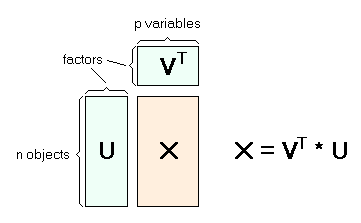 You are working with the text-only light edition of "H.Lohninger: Teach/Me Data Analysis, Springer-Verlag, Berlin-New York-Tokyo, 1999. ISBN 3-540-14743-8". Click here for further information.
You are working with the text-only light edition of "H.Lohninger: Teach/Me Data Analysis, Springer-Verlag, Berlin-New York-Tokyo, 1999. ISBN 3-540-14743-8". Click here for further information.
 You are working with the text-only light edition of "H.Lohninger: Teach/Me Data Analysis, Springer-Verlag, Berlin-New York-Tokyo, 1999. ISBN 3-540-14743-8". Click here for further information. You are working with the text-only light edition of "H.Lohninger: Teach/Me Data Analysis, Springer-Verlag, Berlin-New York-Tokyo, 1999. ISBN 3-540-14743-8". Click here for further information.
|
Table of Contents  Multivariate Data Multivariate Data  Modeling Modeling  Factor Analysis Factor Analysis  Factor Analysis Factor Analysis |
|
| See also: PCA |   |
Factor analysis has a long history with its root in psychology. The first development was reported by Hotelling in 1933. Later on, other authors extended this method, finally resulting in a range of various methods which are difficult to overlook. An excellent book on factor analysis was published by Paul Horst [Horst 1965].
One of the possible definitions has been given by Malinowski:
The principle behind factor analysis is quite simple, although the
concrete realization depends on the requirements of the specific situation,
and may be quite demanding: in principle, a data matrix X is split
up into a product of two data matrices:
X = U V
The matrices U and V are called scores and loading matrices, respectively. This can be visualized by the following figure:

The following general rules for finding suitable factors are usually
applied:
Last Update: 2006-Jšn-17